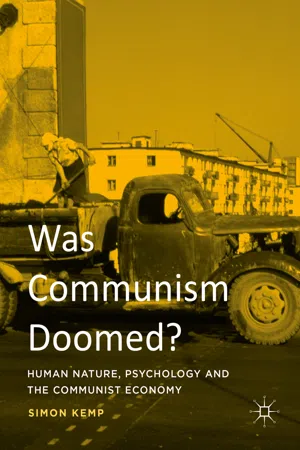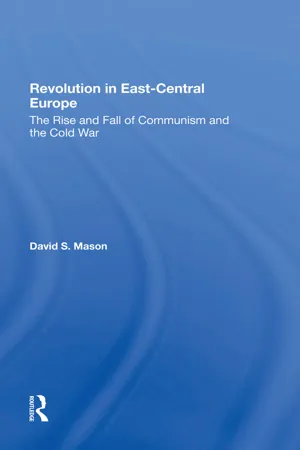History
Spread of Communism
The spread of communism refers to the global expansion of Marxist ideology and the establishment of communist governments in various countries. This expansion was particularly prominent during the 20th century, with the Soviet Union and China playing key roles in promoting communist ideals and supporting revolutionary movements in other parts of the world. The spread of communism had significant geopolitical and ideological implications, shaping international relations and conflicts during this period.
Written by Perlego with AI-assistance
Related key terms
1 of 5
4 Key excerpts on "Spread of Communism"
- eBook - ePub
Was Communism Doomed?
Human Nature, Psychology and the Communist Economy
- Simon Kemp(Author)
- 2016(Publication Date)
- Palgrave Macmillan(Publisher)
The chapter begins with a brief account of communism up to about 1960, focussing mainly on how communist governments arose, particularly in Russia. Then the nature of communist economies in the 1960s and 1970s is outlined, with the major object of explaining how the centrally planned economy actually functioned in practice. As a kind of case study of a communist industry, Russian and Soviet agriculture is considered in a section of its own. This is less because agriculture was a typical communist industry—in fact, it was atypical and unusually dysfunctional—than because it was one that often worried communist leaders themselves. The collapse of communist governments in the USSR and Eastern Europe in the period 1989–1991 is reviewed, with some emphasis on why the collapses occurred. The chapter concludes with a short history of communism in China and Cuba, which are still ruled by communist parties.Political History of Communism up to 1960
The various communist states that appeared in the twentieth century all owed their origin to the economic theory put forward by Karl Marx, particularly in Capital . Marx saw communism as the end point of a series of historical changes in which changes to technology and education affected the way that people interacted with their environment. This theory implied that communism would emerge first in advanced industrial countries, particularly Britain, and then spread to less developed countries. Thus, the fact that a party with a commitment to Marxist theory first came to power in Russia caused some embarrassment to those holding the theory.In the early part of the twentieth century, Russia had industrialised rapidly and achieved impressive economic growth rates. However, the industrial work force in 1917 was considerably outnumbered by the peasantry. The strains and casualties produced by World War 1, in which Russian armies were regularly defeated by the Germans (although not by the Austrians), coupled with some dubious military and political decisions by Tsar Nicholas II and a history of revolutionary discontent, led to the fall of the Tsar’s government in February 1917.2 - CHAPTER 5 The rise and fall of global communism DOI: 10.4324/9781315836119-5
Introduction
The USSR proclaimed it was embarking on a mission to make the whole world communist. After defeating the fascist threat in the Great Patriotic War 1941–45, the world gradually began to turn Red. Starting in Eastern Europe after 1945, states in Asia, Africa, the Caribbean and Latin America joined the communist bloc and took sides in the global conflict between capitalism and communism. Initially, the new communist states accepted the leadership and hegemony of the USSR. They modelled themselves very closely on the pattern of economic transformation, social structure and political leadership adopted in the USSR, and received substantial amounts of aid and resources from the USSR. Inexorably though, differences began to emerge, as each state developed a distinctive national interpretation of the Soviet model of communist theory and practice. Although it was common to talk of the Soviet bloc in monolithic terms, as the decades progressed it became clear that there were a number of different ‘communisms’ in existence. Although all communists in this period declared themselves to be faithful disciples of Marxism–Leninism, committed to the realization of Marx’s ultimate vision of a communist society, they did not agree entirely on the best way to get there, or how quickly to go. In this chapter we will examine briefly the different forms that communism took, and examine the rapid decline of communism in the late 1980s and 1990s. Let us begin close to the communist ‘home’: Eastern Europe.‘Communisms' in Eastern Europe
Why did the states of Eastern Europe turn communist after 1945? The simple answer – because Stalin wanted it – is tempting but deceptive. Clearly Stalin did want it. But why did he want it? Was he hell-bent on global domination for communism, and this was the first step in achieving this aim? Or was he motivated by security concerns after the horrors of the Nazi invasion and occupation? Did he want it because circumstances and international considerations – the wheeling and dealing with Churchill and Roosevelt – had given him a window of opportunity which was just too good to miss? Unearthing his motivations is not easy. But Stalin wasn’t the only person who wanted it. Any explanation of the reasons for the communist takeover needs to take into account the actions and aspirations of local communist leaders, the non-communist political groups and the people of the states of Eastern Europe too (Okey, 1982 ; Fowkes, 1993 - eBook - ePub
Revolution In East-central Europe
The Rise And Fall Of Communism And The Cold War
- David S Mason(Author)
- 2019(Publication Date)
- Taylor & Francis(Publisher)
Warsaw Pact , the Soviet counterpart to NATO. The lines had hardened on both sides of the iron curtain.The Institutions of Communism
Over the next five years, from 1948 to 1953, the communist governments of the region proceeded to establish in their own countries the institutions and policies of Soviet-style communism. This was a time of very rapid change. The Eastern European states accomplished in five years what had taken perhaps twenty years to accomplish in the Soviet Union under Vladimir Lenin (1917-1923) and then Joseph Stalin (1920s through 1953). In part, this was possible because the Eastern Europeans had a ready-made model based on the Soviet experience, and they simply imitated the Soviet pattern in the economic, social, and political spheres.The social policies of the new regimes had elements that were both benevolent and oppressive. Like most modernizing governments, and all socialist ones, the new governments (even in the coalition phase) seized most of the large landed estates and redistributed the property to ordinary peasants and farmers. In some areas, for example in the "Western Territories" of Poland, newly acquired from Germany, this involved a huge amount of land. The government's distribution of this property, often to refugees from farther east, understandably fostered considerable goodwill toward the regime. On the one hand, the new communist-dominated governments also pursued socialist social policies that were often well-received by the population: subsidized housing, health care, education, and guaranteed employment. On the other hand, these more generous policies were accompanied by the restrictive apparatus of the Soviet state as well: an increasingly powerful secret police; restrictions on independent organizations and media; and censorship.Economically, each of the Eastern European states pursued the twin policies of rapid industrialization and collectivization of agriculture (the linchpins of Stalin's first Five-Year Plan begun in 1928). As in the Soviet Union, emphasis was placed on heavy industry (metallurgy, machine tools, engineering, petrochemicals) at the expense of light industry and consumer goods. The economy could be steered in this direction because of increasing state ownership of industry and because of state-controlled central economic planning. A state planning agency (modeled on the Soviet Gosplan) worked with the Council of Ministers and the various governmental ministries (e.g., Ministry of Heavy Industry, Ministry of Metallurgy) to set annual targets for growth of national income and gross output of industry, transportation, construction, and agriculture as well as specific output goals for important producer and consumer goods.6 - eBook - ePub
Revolution And Transition In East-central Europe
Second Edition
- David Mason(Author)
- 2018(Publication Date)
- Routledge(Publisher)
Warsaw Pact , the Soviet counterpart to NATO. The lines had hardened on both sides of the iron curtain.The Institutions of Communism
Over the next five years, from 1948 to 1953, the communist governments of the region proceeded to establish in their own countries the institutions and policies of Soviet-style communism. This was a time of very rapid change. The Eastern European states accomplished in five years what had taken perhaps twenty years to accomplish in the Soviet Union under Vladimir Lenin (1917-1923) and then Joseph Stalin (1920s through 1953). In part, this was possible because the Eastern Europeans had a readymade model based on the Soviet experience, and they simply imitated the Soviet pattern in the economic, social, and political spheres.The social policies of the new regimes had elements that were both benevolent and oppressive. Like most modernizing governments, and all socialist ones, the new governments (even in the coalition phase) seized most of the large landed estates and redistributed the property to ordinary peasants and farmers. In some areas, for example in the “Western Territories” of Poland, newly acquired from Germany, this involved a huge amount of land. The government’s distribution of this property, often to refugees from farther east, understandably fostered considerable goodwill toward the regime. On the one hand, the new communist-dominated governments also pursued socialist social policies that were often well-received by the population: subsidized housing, health care, education, and guaranteed employment. On the other hand, these more generous policies were accompanied by the restrictive apparatus of the Soviet state as well: an increasingly powerful secret police; restrictions on independent organizations and media; and censorship.Economically, each of the Eastern European states pursued the twin policies of rapid industrialization and collectivization of agriculture (the linchpins of Stalin’s first Five-Year Plan begun in 1928). As in the Soviet Union, emphasis was placed on heavy industry (metallurgy, machine tools, engineering, petrochemicals) at the expense of light industry and consumer goods. The economy could be steered in this direction because of increasing state ownership of industry and because of state-controlled central economic planning. A state planning agency (modeled on the Soviet Gosplan) worked with the Council of Ministers and the various governmental ministries (e.g., Ministry of Heavy Industry, Ministry of Metallurgy) to set annual targets for growth of national income and gross output of industry, transportation, construction, and agriculture as well as specific output goals for important producer and consumer goods.6
Index pages curate the most relevant extracts from our library of academic textbooks. They’ve been created using an in-house natural language model (NLM), each adding context and meaning to key research topics.



